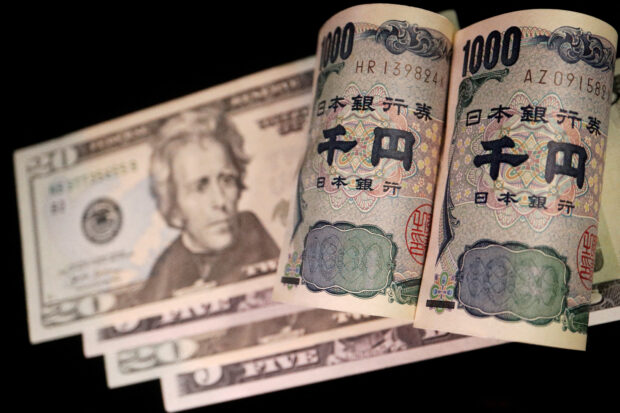
Banknotes of Japanese yen and U.S. dollar are seen in this illustration picture taken Sept 23, 2022. REUTERS/Florence Lo/File photo
SINGAPORE — The dollar climbed on Wednesday in the wake of more strong U.S. economic data, nudging the Japanese yen to a 34-year low and into the zone that drew official market intervention in 2022.
The yen traded at 151.97 per dollar in the Asia session, down about 0.2 percent and weaker than 151.94 where Japanese authorities stepped in during October 2022 to buy the currency and its weakest level since the middle of 1990.
For the quarter ending later this week the yen is the worst-performing major, down more than 7 percent on the dollar even after Japan’s exit last week from negative interest rates.
Officials have been making near daily warnings against speculative moves and markets are jittery about a test of 152 per dollar as Finance Minister Shunichi Suzuki said Japan won’t rule out any steps if it thinks the yen is falling too fast.
READ: Japan says it won’t rule out any steps to stem weak yen
“The market is very sensitive to the 152 area,” said National Australia Bank strategist Rodrigo Catril.
“If we were to break that level then recent history would suggest that intervention would be much more likely.”
BOJ policymaker Naoki Tamura said on Wednesday the central bank must proceed slowly but steadily toward normalizing its policies – seemingly giving the yen a little push weaker.
The move set the dollar higher more broadly, with the Chinese yuan and New Zealand dollar sold very close to four-month lows.
The yuan weakened to 7.2285 per dollar despite a strong fix of its trading band by the central bank. The New Zealand dollar fell 0.2 percent to $0.5988. New Zealand’s Treasury revised its economic growth forecasts lower on Tuesday.
Most currencies slip vs dollar
Australian data published in the morning showed inflation holding at a two-year low of 3.4 percent in February, reinforcing market wagers that the next move in interest rates would be down. The Aussie slipped 0.3 percent to $0.6515.
READ: Australia February inflation holds at two-year low of 3.4%
It is down 4.4 percent for the quarter. Other moves in Asia were kept in check as markets wait for Friday’s release of U.S. core inflation data.
Overnight data showed a bigger-than-expected jump in U.S. durable goods orders in February. While that only partly made up for a large drop in January and came with sub-par consumer confidence data, it pushed the dollar up a little bit.
The euro, at $1.0825 is more or less in the middle of a range it has kept for a year and is down 1.9 percent for a quarter where expectations for U.S. rate cuts have been scaled back.
The Swiss franc, still reeling from a surprise rate cut in Switzerland last week, fell about 0.5 percent on the dollar to a four-month low of 0.9042 overnight.
It is down about 7 percent for the first quarter of the year. The U.S. dollar index is up 3 percent for the quarter to 104.4.
Sterling was steady at $1.2621 and was broadly steady for the quarter, too, down just 0.8 percent.
On Tuesday Bank of England policymaker Catherine Mann said she changed her mind to vote for a rate hold last week, instead of a hike, due to consumers turning more stingy. But she still believes financial markets have too many cuts priced in.

